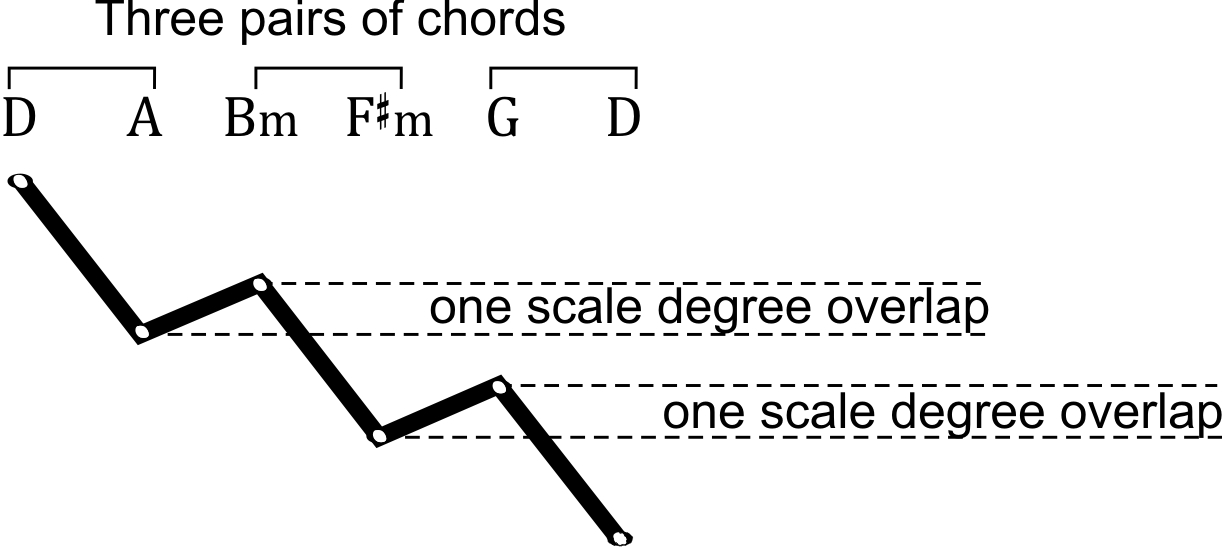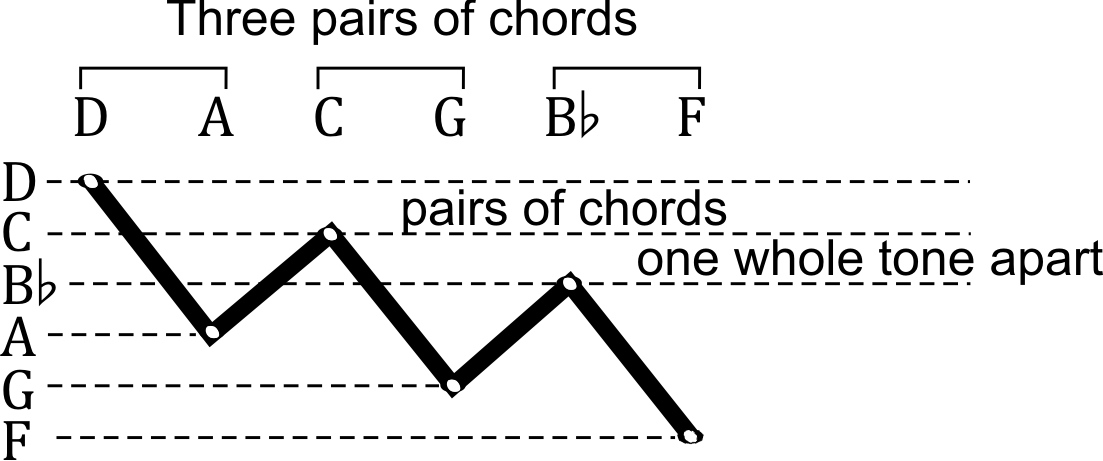The Musicarta Canon Project Module Sixteen
Further Harmonic Variations
Knowing one single chord sequence – especially the Canon – and one key really well, opens the door to great creative freedom. This module contains a number of examples of the kind of experimentation you could be capable of if you continue to work on the Canon chord sequence the Musicarta way.
AABA form
The Canon cycles through the same simple eight-chord sequence numerous times, and relies on layering up instruments and melodic lines for its attraction. Then it ends, again very simply.
Most songs, though, aren’t quite so simple. They often have an additional, different bit of material, slotted into the repeating ‘same’ section. Very often, the different section is slotted in as the third in a set of four phrases, giving what is called ‘AABA form’.
(Note that ‘A’ and ‘B’ have nothing to do with keys, chords or notes. They simply indicate that the three ‘A’ sections are the same or similar, while the ‘B’ section is different.)
Here are some possible ‘Canon-based 32-bar ‘AABA’ songs/pieces.
Here is a Canon-based AABA chord sequence which uses only the familiar Canon chords.
Here is the chord sequence.

Examine the chord sequence. Note that the first, second and fourth lines are the same, and the third line is different – AABA form. The fifth line of the sequence is an extended ending. The abbreviation (s–r) stands for suspension–resolution. The chord symbol G :A in the fifth line indicates that the four counts in that bar are split between those two chords. (This is a universal convention.)
Here is the same performance with another possible B section:
Here is the chord sequence.

Notice the F#/A# slash chord in the new B section (third line of the sequence) The F# chord in the Canon is usually a minor chord – F#m. There is no ‘m’ here, so the chord has to be major, and the third, note A, will be sharpened. This is the A# you play in the bass.
Mediant substitution
Mediant substitution is a powerful way of getting more out of any chord sequence.
The ‘mediant’ chord in a key is the chord built on the third note of the scale up from the tonic – the F sharp minor chord in the key of D. The ‘submediant’ chord in a key is the chord built on the note a third down from the tonic (the sixth scale degree) – B minor in key D.
Mediant substitution involves shifting the root and/or the chord up or down a third to generate rich new harmonies. This usually creates a seventh chord.
Play the first four chords of the Canon, then lower the roots a third and play them again. You get this.

Immediately the chords sound a lot more modern. You can hear the potential of the chord sequence.
The slash-chord names of the altered chords in the music example above are not proper names – they just describe how the chords have been put together. Here is the same music with the chords named correctly:

(You can learn all about seventh chords on the Musicarta site.)
Follow the same procedure with the last four chords in the chord sequence. You play the same chords in the right hand but lower the bass line a third. The original chords here get too low for this treatment, so inversions have been used.

The complete bass mediant substitution chord sequence follows.

Here’s a possible rendition in slow jazz waltz rhythm.
The entire chord sequence has moved into a modal relative minor. Explore the Modes Workbook on the Musicarta site if you find these harmonies attractive.
Note: Some music theory texts distinguish between 'mediant' and 'submediant' substitution. Musicarta has not done so in this section. You can experiment with keeping the bass the same and changing the right hand chord to the ‘third up’ substitute chord.
Fourths overlapping by only one tone
The three pairs of chords in the Canon chord sequence overlap by one scale degree. You will recognise the familiar bass line shape:

We can generate interesting chord sequences by having three pairs of chords the same size (i.e. roots still dropping a fourth) spaced one whole tone apart:

Listen to the two versions.
The ‘whole tone apart’ version is a lot more rock-sounding. Note that it takes us well outside the D major scale (C natural, F natural, B flat), and that all the chords are major.
Here’s a riff based on this ‘whole tone apart’ chord sequence. ‘Build-up’ suggestions follow.
Here’s the chord sequence.

Everything, as far as possible, is in whole-tone steps: F – G – A at the end of the first half, Bë – C – D at the end of the second half (and repeated).
When you hear a ‘busy’ riff like this that you might like to play, the first thing you do is try to listen through to the underlying chords. Here they are.
Of course, you want to know what the top note of the right hand chord is. The top note is easiest to hear. This musical shorthand is as good as written-out music.

The riff above demonstrates all the chord changes in as short a time as possible – as do most of the Musicarta Canon Project riffs. You don’t have to play all the chords, or change quite so quickly. Just the first two pairs – chords D, A, C and G – are ample for a basic song sequence.
Here’s the chord sequence used.
Try transposing the riff using chords C – G – Bë – F, or G – D – F – C. The formula is:
- Two pairs of chords, the second pair a whole tone below the first.
- In each pair, both chords are major and the root falls a fourth.
Often, in the act of transposing, the keys feel different under your fingers and you stumble upon a slightly different version. This is often how musical creation takes place, so seize your variations boldly and ‘lock them in’! Make a quick recording or jot down a musical shorthand version, then come back to them and work them up into your own piece or song.
This is the last module in the Musicarta Canon Project.
Looking forward, you are now in a position to use your in-depth knowledge of the Canon’s seminal chord sequence as a springboard for developing your musical understanding and skills.
For example, your familiarity with the Canon chord sequence offers a significant opportunity to improve your aural skills, and know just by listening what chords are being used in a song. Your repeated, focussed listening to the Canon chord sequence provides a solid foundation for the ‘educated guesswork’ that underpins this seemingly magical skill.
Most mainstream pop/rock songs don’t stray far from the chords that are natural to their key, like the Canon chords in D major (with the addition of E minor, as discussed in Module Fifteen). Listen to the ‘golden oldies’ shows on your radio, or to your 60s/70s/80s Greatest Hits compilations and ask yourself, “If this song was in D (like the Canon), what would that chord be?”
Transposing is key to musical creativity. Keep going back to the Roman numeral system of naming chords until it becomes second nature. Play the Canon chord sequence (the ‘usual string of triads’) in five different keys every day. Use inversions in the right hand to make top-note tunes, and transpose again. Transpose the harmonic variations in this Module Fifteen and Sixteen into other keys.
In the end, though, nothing beats just ‘messing around’. Learners find it hard to accept that they can, in fact, ‘just sit down and play’. Often, this is a matter of unrealistic expectations – of expecting to improvise something perfect, out of the blue, first time off.
More often, however, what you create is based on something you already know – the Canon chord sequence, for example, plain or altered – and is a performance built from repeated not-quite-there-yet attempts, probably with some aids-to-memory jotted down along the way. As a start, you can play the Canon chord sequence using a keyboard texture and rhythm copied from another piece or song. Or just loop up a drum track and see what comes up!
There’s lots more chord-based creativity material at musicarta.com. Like the Canon Project, the Pyramids Variations series builds an impressive performance from simple keyboard resources, teaching theory basics along the way. The Pyramids series also goes on to create variations on its chord sequence – the best way to develop creativity.
The Chord Progressions series at musicarta.com builds chord fluency by introducing the key chords one at a time, starting with the famous ‘One, Four, Five’ trio of chords – the basis of vast amounts of popular music, while the Modes series explores how this pre-modern key system can still generate attractively-different chord sequences.
The Musicarta Pentatonics material teaches these ready-made improvising scales, while the Blues and 12-Bar tab will teach you the basics of boogie in no time. There is also material in the Beat and Rhythm section to progressively improve your ability to play complicated off-the-beat music, an essential skill in modern keyboard work.
Make musicarta.com your springboard to keyboard creativity! Have a Musicarta project ‘on the go’ at all times. Your expanding knowledge and educated musical ear will help you listen to your favourite music with an “I can do that!” attitude. Above all, play constructively every day. In music, as elsewhere, persistence pays dividends, and there is hardly anything you can’t achieve with steady work – and Musicarta!
Thanks for visiting MUSICARTA! Come again soon!
|
|
Get an overview of Musicarta in manageable monthly slices – and keep up to date with new postings.
Read all about it on the Musicarta Newsletter page. The Musicarta News - regular encouragement to learn and progress! Or – get the Musicarta RSS feed. [What’s that?] |
|
OUT NOW! |
THE MUSICARTA BEAT & RHYTHM WORKBOOK At last! An effective approach to keyboard rhythm & syncopation skills. Learn more! |
ONLY $24.95! |

















